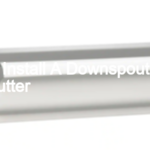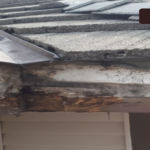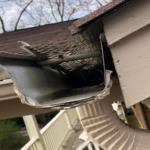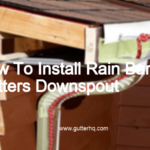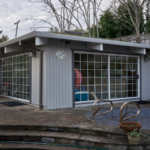A downspout is a pipe that is used to drain water from the roof of a building. There are a few different options that can be used in place of a downspout, such as a gutter, a French drain, or a rain barrel.
What happens if you don’t have a downspout?
If you don’t have a downspout, you could end up with a flooded basement or water damage to your foundation. A downspout is an important part of your home’s drainage system, and without one, water can collect around your home and cause serious damage.
How do you handle rain runoff without gutters?
One way to handle rain runoff without gutters is to install a French drain. This is a drainage system that consists of a perforated pipe that is buried in a gravel-filled trench. The pipe collects the water and directs it away from the foundation of the house.
Another way to handle rain runoff is to install a rain garden. This is a garden that is planted in an area that is prone to flooding. The plants in the rain garden help to absorb the water and prevent it from causing damage to the property.
yet another way to manage rain runoff is to create a swale. This is a shallow ditch that is created on the contour of the land. The swale helps to direct the water away from the foundation of the house and prevents it from causing erosion.
How do you drain water without gutters?
There are a few ways to drain water without gutters. One way is to install a French drain. This is a drain that is installed at the base of a foundation to prevent water from seeping in. Another way is to install a sump pump. This is a pump that is installed in a low spot in the yard and pumps water out of the area.
Do rain chains work as well as downspouts?
Rain chains are a decorative way to channel water from your gutters down to the ground, and they work just as well as traditional downspouts. In fact, they can actually work better than downspouts in some cases.
For one thing, rain chains can be installed so that they funnel water away from your foundation and into a flower bed or garden. This can help to prevent water damage to your foundation and keep your flowers and plants healthy.
Rain chains also tend to be more aesthetically pleasing than downspouts. They come in a variety of styles and can be made from materials like copper or stainless steel. This means that they can add a touch of elegance to your home’s exterior.
If you’re looking for a functional and stylish way to channel water away from your home, rain chains are a great option.
How far can you run a gutter without a downspout?
A gutter is a type of drainage system that is installed along the eaves of a house or building. It is designed to collect and channel water away from the structure, preventing water damage. A downspout is a pipe that is connected to the gutter and extends to the ground, where it drains the water away from the foundation.
If a gutter does not have a downspout, the water will eventually spill over the edge of the gutter and onto the ground. The distance that the water will travel before spilling out of the gutter will depend on the size of the gutter and the amount of rainfall. In general, a gutter should be installed with a downspout every 10 feet to prevent water from spilling over the edge.
Are downspouts necessary?
Yes, downspouts are necessary. They are installed for a reason and that reason is to protect your home from water damage.
Water damage is one of the most common and costly problems homeowners face. Water can damage your foundation, rot your framing, and ruin your finishes and fixtures. And, it can all happen very quickly.
A downspout is a pipe that carries rainwater from your gutters to a drain or to the ground. By redirecting this water away from your home, you can prevent serious water damage.
If you live in an area with a lot of rain, or if your gutters are not properly maintained, you may need more than one downspout to prevent water damage to your home.
How do I redirect water away from my house?
- One way to redirect water away from your house is to install gutters and downspouts. Gutters collect rainwater from your roof and channel it into the downspouts, which carry the water away from your foundation.
- Another way to keep water away from your house is to grade the ground around your foundation so that it slopes away from the house. This will help to prevent water from pooling around your foundation and seeping into your basement or crawlspace.
- You can also install a French drain around the perimeter of your foundation. A French drain is a trench that is filled with gravel and has a pipe running through it. The pipe carries water away from your foundation and helps to keep your basement or crawlspace dry.
- Finally, you can use landscaping to redirect water away from your house. Planting trees, shrubs, and other plants can help to soak up excess water and prevent it from pooling around your foundation.
Why do Arizona homes not have gutters?
Arizona homes do not have gutters because they are not necessary. The state of Arizona is relatively dry, so there is not a lot of rain or snow. Therefore, there is no need to have gutters to collect water. Additionally, Arizona homes are typically built with stucco or brick exteriors, which do not require gutters to protect them from water damage.
How do I stop rain water from pooling in my yard?
- First, identify where the water is pooling in your yard. This will help you determine where to focus your efforts.
- Next, take a look at the surrounding area and grade of your yard. If the land slopes towards your home, this could be contributing to the pooling water.
- To remedy this, you can try one of two things. You can either re-grade the area around your home so that the land slopes away from your house, or you can install a drainage system. This will help to redirect the water away from your home and into a more suitable area.
- If you have trees in your yard, make sure that their roots are not contributing to the pooling water. roots can act as dams, causing water to back up. If you think this may be the case, you can consult with a tree expert to have the roots trimmed or removed.
- Finally, make sure that your gutters and downspouts are clear and functioning properly. Clogged gutters can cause rainwater to pool in your yard instead of being directed away from your home.
Conclusion
There are a few different options that you can use instead of a downspout. You can use a rain barrel, a rain garden, or a French drain. Each option has its own set of pros and cons, so be sure to do your research before making a decision. Whichever option you choose, make sure that you take the necessary steps to ensure that your home is properly protected from water damage.

